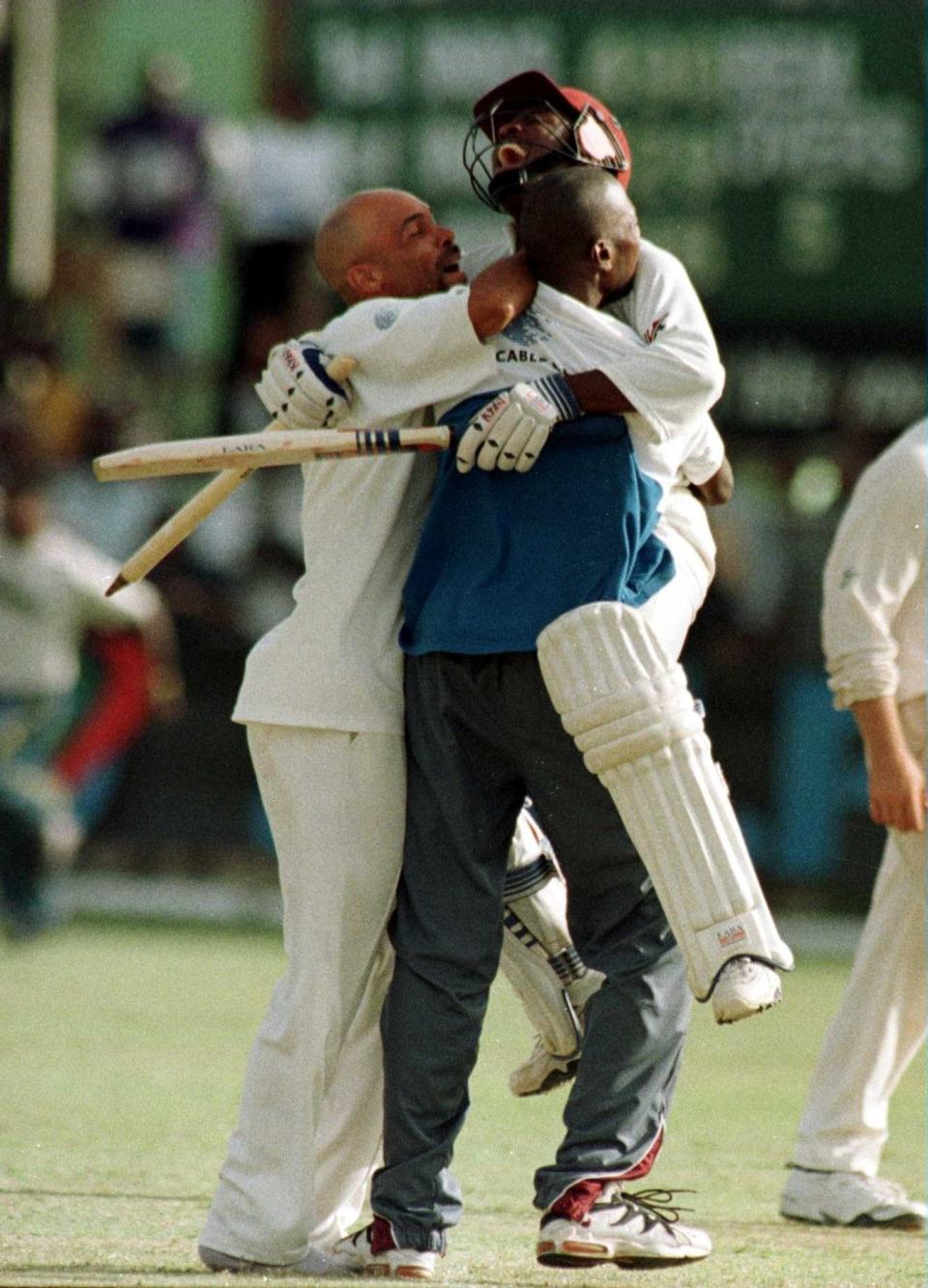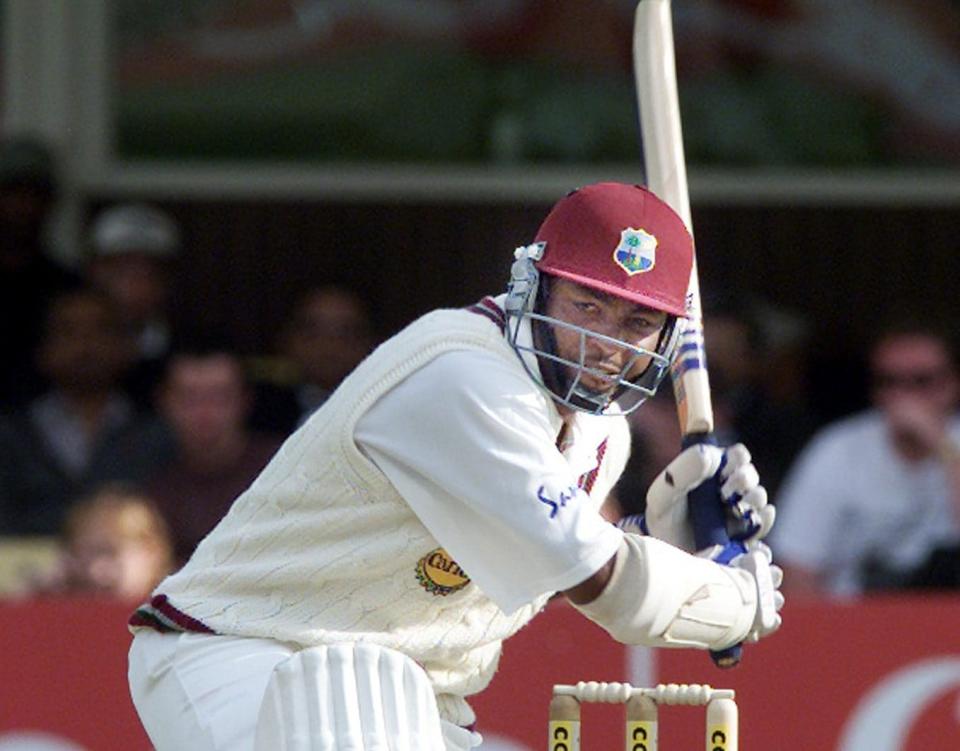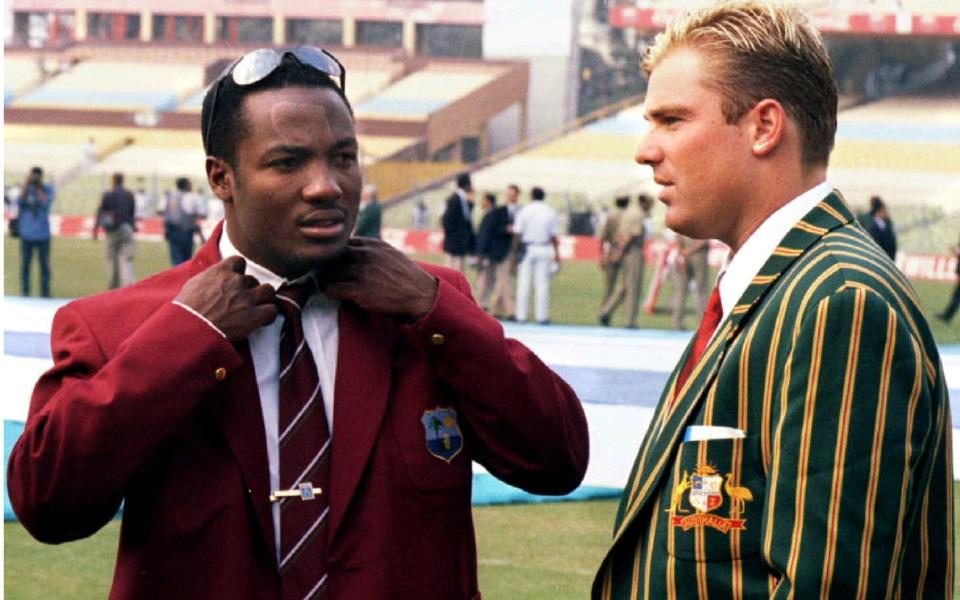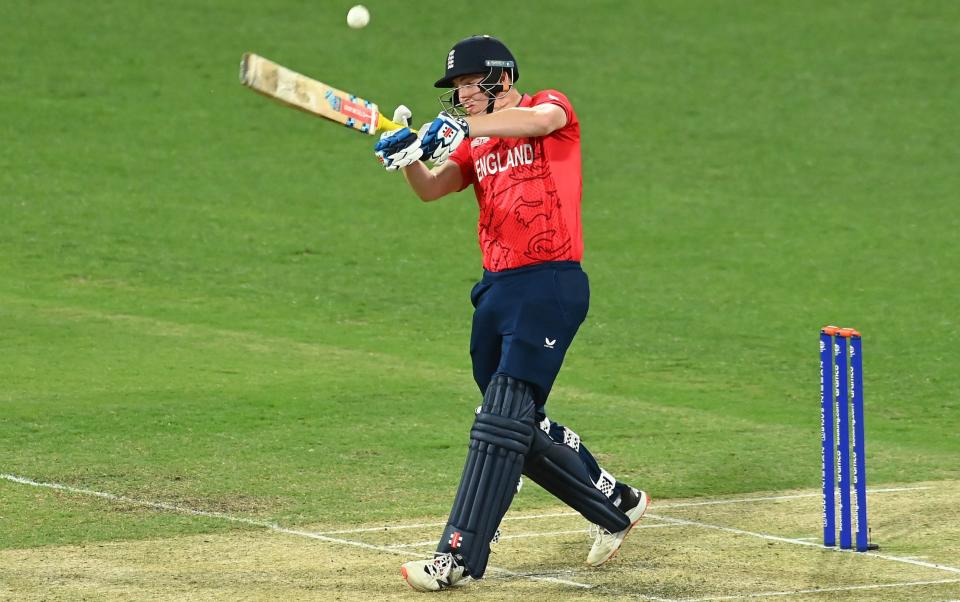
Brian Lara broke the Test world record score twice – and holds the all-time first-class record to boot. Yet he does not consider either his 375, or his undefeated 400 – both made against England in Antigua – or his undefeated 501 for Warwickshire against Durham among his best innings.
“It’s something that I am very appreciative of, to be holding a few records,” Lara says when we meet in Melbourne shortly after the T20 World Cup. “I think it’s destiny.” But he is adamant: “Neither of those two records actually is in the top five innings I’ve ever played.”
The apogee of Lara’s 17 years in international cricket, which ran until 2007, came against Australia in March 1999. The second Test began with calls for Lara to be sacked building to a climax; West Indies had lost six Tests in a row, culminating in being skittled for 51 in the series opener in Port of Spain, Lara’s home town.
In the second Test in Jamaica, West Indies promptly collapsed again, to 34 for four. Then, Lara thrashed 213 to set up victory. “The pressure that I was under,” he reflects. “The state of mind that I was in and what that innings brought out of me showed me how strong I was as an individual.”
A fortnight later, on the fifth morning of the third Test in Barbados, Lara was undefeated on two in the pursuit of 308. He could not sleep. At 5am, he called an old school friend, Nicholas Gomez, who was in Barbados. Gomez was at a nightclub, drinking the night away.
Before the Jamaica Test, Gomez talked Lara through his slump in form; now, he was needed again. In Lara’s room, they watched footage of two of Lara’s most devastating innings against Australia – the double hundreds in Sydney, in 1993, and Jamaica.
“We worked out a plan of ‘how are we gonna score these runs? Who am I gonna attack and defend against?’ I read a lot about Michael Jordan, he felt that visualisation was something that needed to be done. It’s not going to be executed every single time but if you do it you can sort of feel it when you go out into the middle.”
Lara was planning the innings before he played it. “They were going to throw the fast bowlers against me in the first hour of play, but the minute spin came on I was going to attack. If it’s Stuart MacGill, if it’s Shane Warne, I am going to go on the attack because I wanted them to bring the fast bowlers back again while they are tired.” Glenn McGrath would bowl 44 overs out of 120.1 in the West Indies chase.
“I was very focused. A little bit of panic seeped in when we lost Jimmy Adams and we lost two more wickets very quickly at that stage, and I was left with Curtly Ambrose.” West Indies were still 60 shy of victory, with eight wickets down. “You’re 10 boundaries away from winning and if you can pick up a couple of boundaries every over, hopefully Ambrose could survive – we’re going to put them under pressure again. So, I did not lose the belief.”
Ambrose fell with the target still six runs away, leaving Lara only Courtney Walsh, a notorious rabbit, for company. After Walsh survived five fraught deliveries, Lara was on strike with the scores level. Jason Gillespie overpitched fractionally; Lara drove the ball through the covers, then raised his arms as he was engulfed by team-mates and delirious supporters. “It worked out as we planned.”

From the series against Australia, Lara found equilibrium. “I put less pressure on myself, and I put less importance to what people were saying, I wasn’t as angry.” In his last 71 Tests, beginning with the second against Australia in 1999, Lara averaged 55.2, six runs more than in the earlier part of his career.
‘For a period, you survive. It was a mental war coming up against McGrath, Gillespie and Lee’
From his first years, Lara was used to defying the odds. Before becoming the Prince of Trinidad, Lara grew up as the 10th of 11 children. Younger and smaller than those he played with, Lara had to compete through other means.
“I played with my bigger brothers from a very early age,” he says. “That was huge in my development. In the Caribbean, sport is very seasonal so I’d be playing football, I’d be playing cricket, table tennis and just growing and getting involved in everything until finally I said, ‘You need to concentrate on one’.” Aged six, Lara was enrolled in the Harvard Coaching Clinic every Sunday. Here, and in the streets, Lara played sport with Shaka Hislop and Dwight Yorke, who would lead Trinidad and Tobago to the 2006 football World Cup.
In street cricket, Lara learnt his distinctive high backlift. “It might have been even more exaggerated when I was a teenager growing up. It’s just a part of the way I played and happily no one actually tried to change that.”

Lara created the wonderful illusion of batting on instinct alone. Yet his swagger concealed what went into his method. Throughout his career, he believes, “a lot of people didn’t give credit” for how he prepared for matches.
“I trained harder than what I got in the middle. Something I learnt from Michael Jordan, reading his book – to train so hard that when he got out to the middle he was in cruise control. I spent a lot of time in the nets and on my fitness.
“Sometimes you play a sport or you do something that becomes easy for you. You never really challenge yourself in other areas. I felt that doing things outside of just batting challenged me and I understood what it was like to get over obstacles – if it was just my academics, or my fitness, learning how to take difficult situations but trying to compete and be successful. That helped my cricket.”
Lara’s approach at the crease was normally governed by a simple mantra: take his time initially, and then accelerate. “My batting was based around understanding that it was a period of survival. I did carry a nervous energy, as a lot of successful sportsmen will tell you – you have to be nervous. So you embrace that nervousness.
“The majority of the time it was a mental war, coming up against an Australian attack that had McGrath, Gillespie and Brett Lee and winning those mental wars before you actually go on to score something big. I think a lot of young players don’t understand how to put together an innings in your mind before you actually do it with the bat.”
‘I read Warnie easily but he became more difficult as he seemed to get better’
More than anything, Lara stood out for his regal batting against spin. Lara averaged 82.5 against spin in Test cricket, the eighth-highest of anyone in history to play 30 Tests – and had a strike rate of 65.
The antecedents of his prowess lay in softball cricket – normally played with a tennis ball – in Trinidad, which has a rich history of Indo-Caribbean cricketers, who have often been slow bowlers.
“We played with tennis balls, and you can actually chuck the tennis ball,” Lara explains. “In softball cricket, you can chuck it into the pitch, turn it a mile. And I felt that was a huge part of understanding how to play spin from an early age. If you were to ask me ‘spin or pace?’ I’ll tell you spin every single day. It just came as something natural.”
It did not matter how good the spinners were. Against Warne, Lara averaged 71.6 in Tests. Lara had a crucial edge over Warne: he could read his deliveries from the hand.

“A lot of people try to read off the pitch. I think that’s a bit too late. So, I’m trying to understand what’s coming out of the bowler’s hand. I read Warnie quite easily. But what made him great was the fact that he never gave up and he was always going to come out and produce something to confuse you.”
Against Muttiah Muralitharan, the other great spinner of the age, Lara averaged an extraordinary 124. In a series in Sri Lanka in 2001, Lara hit 688 runs in six innings.
“What Murali didn’t realise is that for the first 20 minutes of every innings, I really was not reading him. I kept sweeping and getting a single, getting off strike. And then eventually you start getting accustomed to what he was doing with the ball and then eventually he lost a bit of confidence maybe.
“Murali was harder to face at the beginning of the innings. But as I got better out in the middle, Warne became more difficult because he seemed to get better. Murali knew he could get the rest of the players out so the field would spread and I’d get a single.”
‘Infrastructure is lacking in West Indies, we take talent and make it ordinary’
For all his dazzling batsmanship, Lara was fated to play through the decline of the West Indies; only one player has registered more than his 63 Test defeats. Rather than laments about players not respecting the maroon cap, Lara has an altogether more prosaic explanation for the struggles: the inequality in facilities, which was a problem during his career and has become more pronounced since.
“Well, it’s simple, always infrastructure. When you come to Australia, of course it’s a big country, they have huge investment in sports. That’s something that’s lacking in West Indies. Everyone is looking for the next superstar, if he’s Usain Bolt or Viv Richards, to just come out of nowhere and be as brilliant as they were. To do that you need structure.
“The talent in the Caribbean is amazing. I just think that we take that talent and make it pretty ordinary. In some other countries, the talent could be ordinary, but then ordinary talent is turned into something special. So, it really and truly has to do with the investment.
“Maybe 50, 60 years ago talent was the number one thing. Today is much more about discipline. The technical side of sport, understanding injuries and understanding how to do all sorts of different things, it’s now a whole different ball game. It’s a business and we haven’t caught up with that.
“I was amazed once I went to Loughborough, it must have been in the late Nineties or the early 21st century. They took me to a room and they showed a skeletal version of me – why they felt I was doing certain things and scoring runs. They showed me one of Curtly Ambrose and why they think he doesn’t suffer from stress fractures. I’ve never seen anything like that in the Caribbean.”
‘The game has evolved: these guys are crazy good’
While Lara has been involved in West Indies camps, his first experience as a head coach will be in the Indian Premier League, where he will lead Sunrisers Hyderabad this year.
“I always enjoyed the interaction with especially the younger players. But this is going to be something really new – I am excited and quietly confident. IPL is the league, so it’s not a bad place to start.
“I like having young players on my team and obviously with my experience, a lot of them gravitate towards me. And that’s where I think I would play the most important part. Then you have senior players who you can leave alone and get them into the team plans. When I was a teenager, I remember how much I wanted to hear from the older players. That’s what I’m going to provide.”
It promises to be an education for Harry Brook, who Sunrisers bought for £1.3 million in the auction.

Yet, for all the brilliance of Lara’s past deeds, he is not oblivious to how the game has changed.
“A lot of people start ‘This guy from the past is a much better batter…’ You look at the shots that these guys are playing now. It’s incredible what they’re doing. I must give them kudos. The game has evolved, has developed and these guys are crazy good. If I was to transport myself into the spirit, I feel yes, I would survive, and I’d do well, but I’d love to develop a few more shots, the ramp and the reverse sweep. The regularity that they do it now – it’s just unbelievable.”
He marvels at watching Jos Buttler in the World Cup final, reacting to a mesmerising spell from Naseem Shah by ramping a delivery outside off stump over fine leg for six. “You don’t do things like that. It’s amazing to see.”
Watching Lara was often the same.
Article courtesy of
Source link